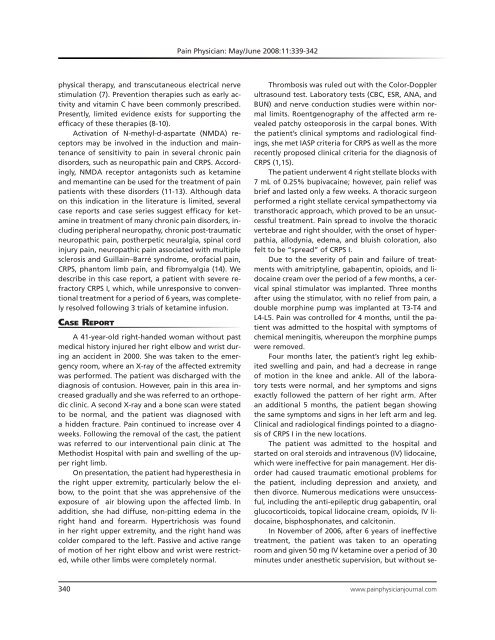Ketamine Treatment for Intractable Pain in a Patient with Severe ...
Ketamine Treatment for Intractable Pain in a Patient with Severe ...
Ketamine Treatment for Intractable Pain in a Patient with Severe ...
You also want an ePaper? Increase the reach of your titles
YUMPU automatically turns print PDFs into web optimized ePapers that Google loves.
<strong>Pa<strong>in</strong></strong> Physician: May/June 2008:11:339-342<br />
Thrombosis was ruled out <strong>with</strong> the Color-Doppler<br />
ultrasound test. Laboratory tests (CBC, ESR, ANA, and<br />
BUN) and nerve conduction studies were <strong>with</strong><strong>in</strong> normal<br />
limits. Roentgenography of the affected arm revealed<br />
patchy osteoporosis <strong>in</strong> the carpal bones. With<br />
the patient’s cl<strong>in</strong>ical symptoms and radiological f<strong>in</strong>d<strong>in</strong>gs,<br />
she met IASP criteria <strong>for</strong> CRPS as well as the more<br />
recently proposed cl<strong>in</strong>ical criteria <strong>for</strong> the diagnosis of<br />
CRPS (1,15).<br />
The patient underwent 4 right stellate blocks <strong>with</strong><br />
7 mL of 0.25% bupivaca<strong>in</strong>e; however, pa<strong>in</strong> relief was<br />
brief and lasted only a few weeks. A thoracic surgeon<br />
per<strong>for</strong>med a right stellate cervical sympathectomy via<br />
transthoracic approach, which proved to be an unsuccessful<br />
treatment. <strong>Pa<strong>in</strong></strong> spread to <strong>in</strong>volve the thoracic<br />
vertebrae and right shoulder, <strong>with</strong> the onset of hyperpathia,<br />
allodynia, edema, and bluish coloration, also<br />
felt to be “spread” of CRPS I.<br />
Due to the severity of pa<strong>in</strong> and failure of treatments<br />
<strong>with</strong> amitriptyl<strong>in</strong>e, gabapent<strong>in</strong>, opioids, and lidoca<strong>in</strong>e<br />
cream over the period of a few months, a cervical<br />
sp<strong>in</strong>al stimulator was implanted. Three months<br />
after us<strong>in</strong>g the stimulator, <strong>with</strong> no relief from pa<strong>in</strong>, a<br />
double morph<strong>in</strong>e pump was implanted at T3-T4 and<br />
L4-L5. <strong>Pa<strong>in</strong></strong> was controlled <strong>for</strong> 4 months, until the patient<br />
was admitted to the hospital <strong>with</strong> symptoms of<br />
chemical men<strong>in</strong>gitis, whereupon the morph<strong>in</strong>e pumps<br />
were removed.<br />
Four months later, the patient’s right leg exhibited<br />
swell<strong>in</strong>g and pa<strong>in</strong>, and had a decrease <strong>in</strong> range<br />
of motion <strong>in</strong> the knee and ankle. All of the laboratory<br />
tests were normal, and her symptoms and signs<br />
exactly followed the pattern of her right arm. After<br />
an additional 5 months, the patient began show<strong>in</strong>g<br />
the same symptoms and signs <strong>in</strong> her left arm and leg.<br />
Cl<strong>in</strong>ical and radiological f<strong>in</strong>d<strong>in</strong>gs po<strong>in</strong>ted to a diagnosis<br />
of CRPS I <strong>in</strong> the new locations.<br />
The patient was admitted to the hospital and<br />
started on oral steroids and <strong>in</strong>travenous (IV) lidoca<strong>in</strong>e,<br />
which were <strong>in</strong>effective <strong>for</strong> pa<strong>in</strong> management. Her disorder<br />
had caused traumatic emotional problems <strong>for</strong><br />
the patient, <strong>in</strong>clud<strong>in</strong>g depression and anxiety, and<br />
then divorce. Numerous medications were unsuccessful,<br />
<strong>in</strong>clud<strong>in</strong>g the anti-epileptic drug gabapent<strong>in</strong>, oral<br />
glucocorticoids, topical lidoca<strong>in</strong>e cream, opioids, IV lidoca<strong>in</strong>e,<br />
bisphosphonates, and calciton<strong>in</strong>.<br />
In November of 2006, after 6 years of <strong>in</strong>effective<br />
treatment, the patient was taken to an operat<strong>in</strong>g<br />
room and given 50 mg IV ketam<strong>in</strong>e over a period of 30<br />
m<strong>in</strong>utes under anesthetic supervision, but <strong>with</strong>out sephysical<br />
therapy, and transcutaneous electrical nerve<br />
stimulation (7). Prevention therapies such as early activity<br />
and vitam<strong>in</strong> C have been commonly prescribed.<br />
Presently, limited evidence exists <strong>for</strong> support<strong>in</strong>g the<br />
efficacy of these therapies (8-10).<br />
Activation of N-methyl-d-aspartate (NMDA) receptors<br />
may be <strong>in</strong>volved <strong>in</strong> the <strong>in</strong>duction and ma<strong>in</strong>tenance<br />
of sensitivity to pa<strong>in</strong> <strong>in</strong> several chronic pa<strong>in</strong><br />
disorders, such as neuropathic pa<strong>in</strong> and CRPS. Accord<strong>in</strong>gly,<br />
NMDA receptor antagonists such as ketam<strong>in</strong>e<br />
and memant<strong>in</strong>e can be used <strong>for</strong> the treatment of pa<strong>in</strong><br />
patients <strong>with</strong> these disorders (11-13). Although data<br />
on this <strong>in</strong>dication <strong>in</strong> the literature is limited, several<br />
case reports and case series suggest efficacy <strong>for</strong> ketam<strong>in</strong>e<br />
<strong>in</strong> treatment of many chronic pa<strong>in</strong> disorders, <strong>in</strong>clud<strong>in</strong>g<br />
peripheral neuropathy, chronic post-traumatic<br />
neuropathic pa<strong>in</strong>, postherpetic neuralgia, sp<strong>in</strong>al cord<br />
<strong>in</strong>jury pa<strong>in</strong>, neuropathic pa<strong>in</strong> associated <strong>with</strong> multiple<br />
sclerosis and Guilla<strong>in</strong>–Barré syndrome, orofacial pa<strong>in</strong>,<br />
CRPS, phantom limb pa<strong>in</strong>, and fibromyalgia (14). We<br />
describe <strong>in</strong> this case report, a patient <strong>with</strong> severe refractory<br />
CRPS I, which, while unresponsive to conventional<br />
treatment <strong>for</strong> a period of 6 years, was completely<br />
resolved follow<strong>in</strong>g 3 trials of ketam<strong>in</strong>e <strong>in</strong>fusion.<br />
Case Report<br />
A 41-year-old right-handed woman <strong>with</strong>out past<br />
medical history <strong>in</strong>jured her right elbow and wrist dur<strong>in</strong>g<br />
an accident <strong>in</strong> 2000. She was taken to the emergency<br />
room, where an X-ray of the affected extremity<br />
was per<strong>for</strong>med. The patient was discharged <strong>with</strong> the<br />
diagnosis of contusion. However, pa<strong>in</strong> <strong>in</strong> this area <strong>in</strong>creased<br />
gradually and she was referred to an orthopedic<br />
cl<strong>in</strong>ic. A second X-ray and a bone scan were stated<br />
to be normal, and the patient was diagnosed <strong>with</strong><br />
a hidden fracture. <strong>Pa<strong>in</strong></strong> cont<strong>in</strong>ued to <strong>in</strong>crease over 4<br />
weeks. Follow<strong>in</strong>g the removal of the cast, the patient<br />
was referred to our <strong>in</strong>terventional pa<strong>in</strong> cl<strong>in</strong>ic at The<br />
Methodist Hospital <strong>with</strong> pa<strong>in</strong> and swell<strong>in</strong>g of the upper<br />
right limb.<br />
On presentation, the patient had hyperesthesia <strong>in</strong><br />
the right upper extremity, particularly below the elbow,<br />
to the po<strong>in</strong>t that she was apprehensive of the<br />
exposure of air blow<strong>in</strong>g upon the affected limb. In<br />
addition, she had diffuse, non-pitt<strong>in</strong>g edema <strong>in</strong> the<br />
right hand and <strong>for</strong>earm. Hypertrichosis was found<br />
<strong>in</strong> her right upper extremity, and the right hand was<br />
colder compared to the left. Passive and active range<br />
of motion of her right elbow and wrist were restricted,<br />
while other limbs were completely normal.<br />
340 www.pa<strong>in</strong>physicianjournal.com
















